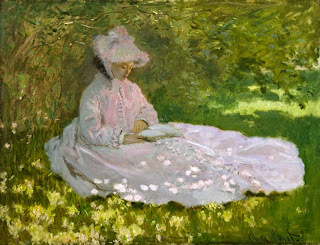 |
| Paul Durand-Ruel, Renoir |
If
the first few months of the year nearly saw me miss Goya at the Courthauld and
Dumas at the Tate Modern, I managed to get organised in time – just – to book
almost a whole week in advance in order to catch Inventing Impressionism at the National Gallery,
with just days to go.
It
closes at the end of the month and had been one of my long-intended visits –
with the intention being for the first few days. But such is life.
In
the event, it was a delightful trip – and a fascinating one.
The
exhibition is built around the life and work of Paul Durand-Ruel – not an
artist himself, but one of the very first dealers in the way we understand that
term today.
But
more than a century before the Satchis got into the art market, Durand-Raul
found himself representing artists who had been rejected by the Salon, the
heart of France’s stifling art establishment.
 |
| Hanging the Laundry Out to Dry (18755), Morisot |
We
begin with a room that recreates (in part) one of the dealer’s own – complete
with double doors decorated by Monet. It’s a room that is full of Renoir.
Now
after last summer’s Paris art orgy, The Other Half and I felt that, if we never
saw another Renoir it would be too soon.
But here were plenty more – and, in
general, they did nothing to convince us that his work was anything other than
garish, chocolate-box sentimental.
There’s
an odd exception: a portrait of Durand-Ruel from 1910 is just such an example.
But all too rare.
 |
| Poplars (1891), Monet |
Since
last July had finally seen a visit to the Orsay in Paris, we felt fairly well
versed in Impressionism, but while we were able to reacquaint ourselves with
some works – I got quite excited on approaching Monet’s Autumn Effect at
Argenteuil
(1873), which I recognised instantly and from a distance as being from the
Courthauld – there was plenty of other works to see that we had not previously.
Durand-Ruel’s
story is a fascinating one. But this excellently-curated exhibition leaves us
with an indelible understanding of his impact on art.
For
instance, he effectively invented the retrospective: one room is dedicated to
this idea, bringing together a span of works by Monet – the first artist to
have his career treated in such a way.
But
it gets better.
This
room includes six of the original 15 Poplars works of Monet’s that Durand-Ruel
displayed in a single exhibition – again, the first of its kind.
 |
| Springtime (1872), Monet |
Brought
together from across the world, they are a joy to behold. The light captured in
them is lovely.
Durand-Ruel
didn’t necessarily have a great deal of success in selling the works he bough,
often in bulk, from the Impressionists. But he ensured that became known, not
just in France, but internationally.
 |
| The Child's Bath (1893), Cassatt |
There
is also plenty of Manet here, plus Degas (horses and ballet dancers) and some
Morisot.
Pre-Impressionist
context is provided early on with some Delacroix, Corot, Courbet, Millet (a
massive influence on Van Gogh) and Rousseau.
The
latter’s View of Mont Blanc, seen from La Faucille (1863-67) is wonderful,
even though compositionally it really should not work. But that’s great art for
you – and an example of how there is so much to learn from studying any work.
This
wasn’t just a case of ‘renewing acquaintances’. We encountered some ‘new’artists (for us).
Eugène Boudin (who first introduced Monet to painting outdoors) was older than most of the Impressionists. His delightful The Entrance to Trouville Harbour (1888) was purchased for the National Gallery instead of a painting by Monet – that his work had not been exhibited by Durand-Reul counted in his favour with the board, apparently.
 |
| The Entrance to Touville Harbour (1888), Boudin |
Coincidentally, the Monet that it would have received in 1905 – Lavacourt Under Snow (circa 1878-81) – came into the gallery’s possession as part of a bequest in 1917.
And then there's Mary Cassatt, an American artist who lived most for most of her life in France, and represented here with The Child’s Bath from 1893.
She was to be valuable to Durand-Ruel in introducing him to many wealthy patrons in the US.
Indeed, the exhibition allows
those of us on this side of the Atlantic to see a lot of works that usually
hang in galleries in the US.
 |
| Music in the Tuileries Gardens (1862), Manet |
It also confirmed that I now know my Monet from my Manet (finally!).
You
cannot see the likes of Manet’s Music in the Tuileries Gardens (1862) without
marvelling at his use of black.
And you cannot see Monet without marvelling at the light.
It
confirmed that a year has not changed the minds of either me or The Other Half
regarding Renoir, although it did remind us how good Pissaro and Sisley were.
And it served as a further reminder that Impressionism has many faces.
It
is an exhibition that is well worth catching. There’s a week left.
No comments:
Post a Comment